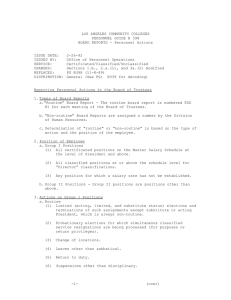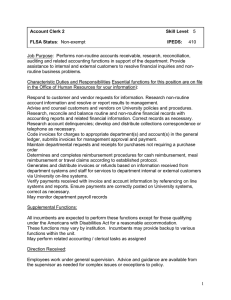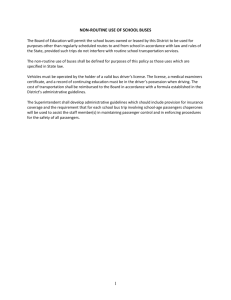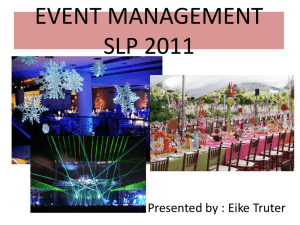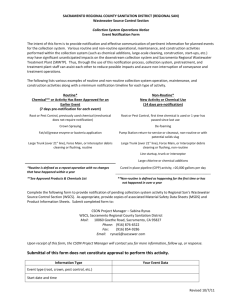Document 14597913
advertisement
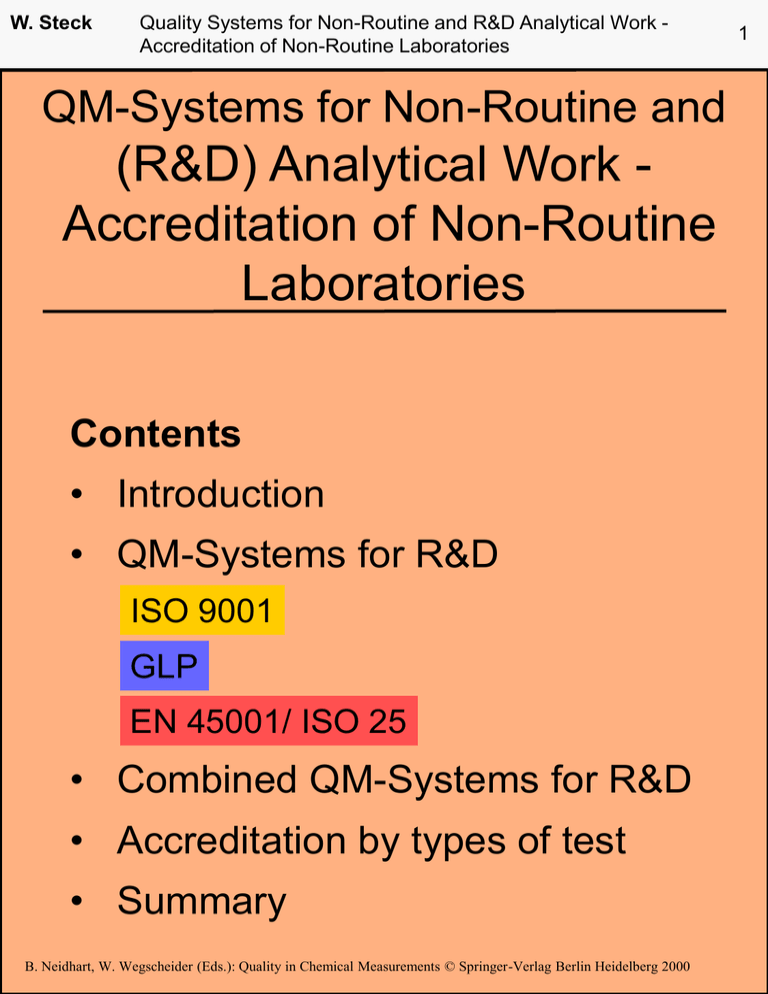
W. Steck Quality Systems for Non-Routine and R&D Analytical Work Accreditation of Non-Routine Laboratories QM-Systems for Non-Routine and (R&D) Analytical Work Accreditation of Non-Routine Laboratories Contents • Introduction • QM-Systems for R&D ISO 9001 GLP EN 45001/ ISO 25 • Combined QM-Systems for R&D • Accreditation by types of test • Summary B. Neidhart, W. Wegscheider (Eds.): Quality in Chemical Measurements © Springer-Verlag Berlin Heidelberg 2000 1 W. Steck Quality Systems for Non-Routine and R&D Analytical Work Accreditation of Non-Routine Laboratories Some Characteristics of NonRoutine or R&D Analytical Laboratories • Expanded methodological range • Complex/multidisciplinary work • High innovation rate concerning test items and test methods: permanently changing analytical tasks • Large number of test methods • Modifications of given methods and development of new methods • Non-Routine analytical work • R&D analytical work, e.g. ad-hoc testing, non-recurring work B. Neidhart, W. Wegscheider (Eds.): Quality in Chemical Measurements © Springer-Verlag Berlin Heidelberg 2000 2 W. Steck Quality Systems for Non-Routine and R&D Analytical Work Accreditation of Non-Routine Laboratories 3 Examples for Routine, Non-Routine and R&D Analytical Work Routine Non-Routine R&D - Matrix and analyte known; method known and in use - Matrix and analyte known; method known, but rarely performed - Matrix and analyte known; method available, but (until now) no experience with method (verification necessary) - Matrix and/or analyte new; adaptable method available (some modification and revalidation necessary) - Problem new, no adaptable method available: Development of new validated method - Ad-hoc analysis of new problems including validation case by case (analytical working plan, task leader) - Basic research (research plan, project management) - structure elucidation, interpretation of spectra R NR R&D Overlap between Routine or R&D with Non-Routine B. Neidhart, W. Wegscheider (Eds.): Quality in Chemical Measurements © Springer-Verlag Berlin Heidelberg 2000 W. Steck Quality Systems for Non-Routine and R&D Analytical Work Accreditation of Non-Routine Laboratories EUROPEAN STANDARD EN ISO 9001 Quality Systems-Model for quality assurance in design/development, production, installation and servicing (ISO 9001: 1994) ISO 9001 is generic and independent of any specific industry or economic sector, but it aims preferably to manufacturing and service industries. Scope This international standard is applicable in situations when... a) design is required... b) ...by adequate demonstration of suppliers capabilities in design... B. Neidhart, W. Wegscheider (Eds.): Quality in Chemical Measurements © Springer-Verlag Berlin Heidelberg 2000 4 W. Steck Quality Systems for Non-Routine and R&D Analytical Work Accreditation of Non-Routine Laboratories EUROPEAN STANDARD EN ISO 9001 Research Design • On its own not sufficient to demonstrate technical competence of a testing laboratory. • Well practicable to cover non-technical (non-lab) activities, desk research, consultancy, basic research for knowledge development projects, development of products and processes. • Suitable for research organisation where laboratory activities are only part of research project. • When applicated to research it should include "R&D project management" as primary process. B. Neidhart, W. Wegscheider (Eds.): Quality in Chemical Measurements © Springer-Verlag Berlin Heidelberg 2000 5 W. Steck Quality Systems for Non-Routine and R&D Analytical Work Accreditation of Non-Routine Laboratories ISO 9001 Design Control - an Example (Chapter 4.4) Quality Management in Design Control Quality Management Directive No. 4 Design contribution to product and process development Date: 23.06.1998 Revision: 1 Page: 1 of 4 Design contribution to product and process development 1 2 3 3.1 3.2 3.3 3.4 3.5 3.6 3.7 4 5 Aims Methods and aids Procedure The phases in a development project Definition of targets and launching the project Laboratory phase Pilot plant phase Production plant phase Steps to be taken if changes are made in the requirements imposed on the product or process to be developed Verification of the results obtained during the development work Responsibilities Documentation and Retention B. Neidhart, W. Wegscheider (Eds.): Quality in Chemical Measurements © Springer-Verlag Berlin Heidelberg 2000 6 W. Steck Quality Systems for Non-Routine and R&D Analytical Work Accreditation of Non-Routine Laboratories The OECD Principles of GLP (Paris1998) Research Design GLP is a quality system concerned with the organisational process and the conditions under which studies are planned, performed, monitored, recorded, archived and reported. One purpose of GLP is to promote the development of comparable quality test data. B. Neidhart, W. Wegscheider (Eds.): Quality in Chemical Measurements © Springer-Verlag Berlin Heidelberg 2000 7 W. Steck Quality Systems for Non-Routine and R&D Analytical Work Accreditation of Non-Routine Laboratories The OECD Principles of GLP (Paris1998) Research Design Pros • Study Director • Study Plan • Knowledgeable personnel in sufficient number • Adequate and controlled test equipment with • - where appropriate - traceable calibration • Selected Standard Operating Procedures (SOP's)* • Validated Computerized Systems • Evaluation and discussion of results • Trackability and Repeatability (Reports, raw data, archive) • Test Facility Management • Facilites • Quality Assurance Programme * when designed as generic test methods B. Neidhart, W. Wegscheider (Eds.): Quality in Chemical Measurements © Springer-Verlag Berlin Heidelberg 2000 8 W. Steck Quality Systems for Non-Routine and R&D Analytical Work Accreditation of Non-Routine Laboratories The OECD Principles of GLP (Paris1998) Research Design Cons • Restricted flexibility, too high degree of details • Formality superior to proper performance • Highly bureaucratic • Excessive Control • Continuing tendency to excessive requirements • Expensive/Unfavourable cost-benefit-ratio • Not adapted to the needs of chemical analysis B. Neidhart, W. Wegscheider (Eds.): Quality in Chemical Measurements © Springer-Verlag Berlin Heidelberg 2000 9 W. Steck Quality Systems for Non-Routine and R&D Analytical Work Accreditation of Non-Routine Laboratories EN 45001 / ISO Guide 25 Research Design • • • • • • • Pros Focusing on technical competence (Potential for more) Flexibility Adapted to analytical testing Higher scope for self-responsibility Generic test methods applicable Cons Continuing tendency to expand requirements Professional judgement excluded from accreditation scope* __________ *The new standard ISO/IEC 17025 allows the inclusion of opinions and interpretations in the test report B. Neidhart, W. Wegscheider (Eds.): Quality in Chemical Measurements © Springer-Verlag Berlin Heidelberg 2000 10 W. Steck Quality Systems for Non-Routine and R&D Analytical Work Accreditation of Non-Routine Laboratories Development and Research (Chapter 4 of ISO 9001) Contents 4.1 Aims and application range 4.2 Definitions 4.3 Responsibilities 4.4 Procedures 4.4.1 Development of test methods 4.4.2 Modification of test methods 4.4.3 Non-Routine testing with respect to accreditation 4.4.4 Validation of test methods 4.4.5 Use of statistical methods for the validation of test methods 4.5 Documentation and archiving 4.5.1 Documentation 4.5.2 Archiving B. Neidhart, W. Wegscheider (Eds.): Quality in Chemical Measurements © Springer-Verlag Berlin Heidelberg 2000 11 W. Steck Quality Systems for Non-Routine and R&D Analytical Work Accreditation of Non-Routine Laboratories 12 Comparison of QM-Standards for Non-Routine and R&D Analytical Work Field ISO 9001 EN 45001/ GLP ISO 25 Organisational Process Project Management Study Director, Study Plan + + +++ Technical Competence +(+) ++(+) + Staff +(+) ++(+) +(+) Equipment +(+) ++ +(+) Facilities + +(+) +(+) Evaluation and Discussion of Results/Professional Judgement - - ++ Quality Assurance Programme Audits, Reviews ++ +(+) ++(+) B. Neidhart, W. Wegscheider (Eds.): Quality in Chemical Measurements © Springer-Verlag Berlin Heidelberg 2000 W. Steck Quality Systems for Non-Routine and R&D Analytical Work Accreditation of Non-Routine Laboratories 13 Application Fields of QM-Systems Degree of detail DIN ISO 9000 ff GLP EN 45001 B. Neidhart, W. Wegscheider (Eds.): Quality in Chemical Measurements © Springer-Verlag Berlin Heidelberg 2000 W. Steck Quality Systems for Non-Routine and R&D Analytical Work Accreditation of Non-Routine Laboratories Combined QM-Systems for R&D Analytical Work ISO 17025 Organisational activities ISO 9001 EURACHEM/ CITAC Guide 2 Technical activities EN 45001/ISO 25 Technical activities GLP Selected elements EN 45001 + NEN 3417 (SC 03) B. Neidhart, W. Wegscheider (Eds.): Quality in Chemical Measurements © Springer-Verlag Berlin Heidelberg 2000 14 W. Steck Quality Systems for Non-Routine and R&D Analytical Work Accreditation of Non-Routine Laboratories Accreditation of Non-Routine Analytical Work by Types of Test Flexibilisation of the scope of accreditation: All means to be taken for accreditation not directed exclusively at the accreditation of individual test methods. The accreditation of types of tests - which is based primarily on measurement principles instead on specific test methods only - is one possibility for flexibilisation of accreditation. B. Neidhart, W. Wegscheider (Eds.): Quality in Chemical Measurements © Springer-Verlag Berlin Heidelberg 2000 15 W. Steck Quality Systems for Non-Routine and R&D Analytical Work Accreditation of Non-Routine Laboratories Testing Fields, Types of Test, Test methods Testing fields Sizable sectors distinguished by common fundaments of a technical, methodological or trained related nature. For example: • Chemical and physico-chemical analysis • Biological investigations • Application tests • Safety tests • Medical laboratory diagnostics B. Neidhart, W. Wegscheider (Eds.): Quality in Chemical Measurements © Springer-Verlag Berlin Heidelberg 2000 16 W. Steck Quality Systems for Non-Routine and R&D Analytical Work Accreditation of Non-Routine Laboratories Testing Fields, Types of Test, Test Methods Types of test Sector of a testing field with similar technicalmethodological features, with comparable calibration, validation and training principles. Types of test may be defined on a technology or application related basis. For example: Testing field Types of test Chemical and physico-chemical analysis Mass spectroscopy NMR spectroscopy UV/VIS-Flourescence spectroscopy IR/Raman-spectroscopy Atomic spectrometry Gas chromatography Migration Waste Water Analysis B. Neidhart, W. Wegscheider (Eds.): Quality in Chemical Measurements © Springer-Verlag Berlin Heidelberg 2000 17 W. Steck Quality Systems for Non-Routine and R&D Analytical Work Accreditation of Non-Routine Laboratories 18 Accreditation of Non-Routine Analytical Work by Types of Test Some features: Testing laboratories are given the opportunity to introduce/develop new test methods within the approved type of test or of modifying existing methods without having to obtain approval from the accreditation authority in each invidual case in advance. It allows confirmation of the competence of Non-Routine analytical activities on the basis of general work (e.g. generic test methods). Making the scope flexible with respect to methodology used does not necessarily imply making it flexible with respect to the test items. B. Neidhart, W. Wegscheider (Eds.): Quality in Chemical Measurements © Springer-Verlag Berlin Heidelberg 2000 W. Steck Quality Systems for Non-Routine and R&D Analytical Work Accreditation of Non-Routine Laboratories 19 Accreditation by Types of Test Proofs of competence: Competent technical staff Knowledge and experience concerning measurement principles, methodology, technology, technical range, science, test items and validation Documented competence like specific test methods, generic test methods, SOPs for non-routine analysis, SOPs related to types of test, scientific reports, test reports and others Adequate and controlled/calibrated equipment B. Neidhart, W. Wegscheider (Eds.): Quality in Chemical Measurements © Springer-Verlag Berlin Heidelberg 2000 W. Steck Quality Systems for Non-Routine and R&D Analytical Work Accreditation of Non-Routine Laboratories 20 Accreditation of Type of Tests Strategy for Selection of Test Methods for GC Technique Sample application split injection splitless injection cold-oncolumn injection temperature programmed vaporization Headspace GC Pyrolysis GC Thermo desorption ... Separation Evaluation method Detection capillary column flame ionization internal standard packed column thermal conductivity external standard column coupling ... mass selective standard addition element specific area-% nitrogen specific thermal energy analyzer electron capture ... isotopic dilution ... Application field analyte/matrix (working range) purity control for release of raw materials and final products (> 90 g/100 g) impurities in chemical products ( 0.01 – 10 g/100 g) residual monomers e.g. VC in PVC ( ng/g - µg/g) N-nitrosamines in air (µg/m 3) Enantiomer separation ... B. Neidhart, W. Wegscheider (Eds.): Quality in Chemical Measurements © Springer-Verlag Berlin Heidelberg 2000 W. Steck Quality Systems for Non-Routine and R&D Analytical Work Accreditation of Non-Routine Laboratories 21 QM-Systems for Non-Routine and R&D Analytical Work Accreditation of Non-Routine Laboratories Summary I. In its current, non-modified version no single QM-System can be recommended as beeing the most suitable for monitoring the quality of Non-Routine and R&D Analytical work. II. Combining the technical focus of EN 45001/ISO 25 with organisational and R&D project management elements taken e.g. from GLP or ISO 9001 has proven as fit for purpose. III. Using the types of test approach the accreditation according to EN 45001/ISO 25 has become flexible enough to deal not only with Routine but also successfully with Non-Routine and R&D Analysis. IV. Non-Routine / R&D Laboratories have already been accredited in Europe according to the schemes II. or III. B. Neidhart, W. Wegscheider (Eds.): Quality in Chemical Measurements © Springer-Verlag Berlin Heidelberg 2000 W. Steck Quality Systems for Non-Routine and R&D Analytical Work Accreditation of Non-Routine Laboratories Accreditation of Non-Routine Laboratories Publications concerning flexible accreditation 1. EAL-P 10, Edition 1, February 1997, The Scope of Accreditation and Consideration of Methods and Criteria for the Assessment of the Scope of Testing. 2. DACH GmbH, Technische Mitteilung, No. 3, Februar 1997, Flexibilisation of the Scope of Accreditation, Accreditation of Type of Tests 3. F. Eggimann, J. Morkowski: An adaptable modular QA-system of a large multi-discipline testing laboratory. Proc. of the 1st Eurolab Symposium, January 28 to 30th, 1992, p. 24-34. 4. F. Eggimann, J. Morkowski: A modular approach for the assessment of the competence of a testing laboratory in a specific testing field. Proc. of the 1st Eurolab Symposium, January 28-30, 1992, p. 501-515. 5. F. Eggimann, R. Fischbach, J. Thies: Experiences with the modular assessment of conformity and competence of a testing laboratory. 2nd Eurolab Symposium, Testing for the years 2000, Florence, Italy, April 94. 6. EURACHEM/CITAC Guide 2, 1998, Annex C 7. Steinhorst, Accred Qual Assur (1998) 3: 294 B. Neidhart, W. Wegscheider (Eds.): Quality in Chemical Measurements © Springer-Verlag Berlin Heidelberg 2000 22
